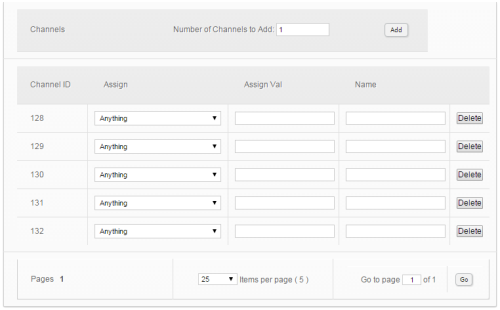Voice Board Settings
Voice board settings appear on the voice board Create and Edit pages.
These settings are typically configured during installation and should only be changed by or under the direction of Uptivity Support. The only exception would be editing or adding channels as needed by your contact center.
This topic provides an overview of voice board settings for reference.
For more information, seeVoice Boards Overview or the
Global Settings
Global settings apply only to voice boards for Ai-Logix LDA and NGX cards.
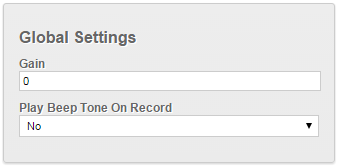
- Gain
- Specifies the volume level (in dBm) to which the board will try to normalize audio. The field accepts any positive or negative numeric value, but the generally accepted range for gain is 1 to -45. The default value is 0. This setting can be used to control multiple Ai-Logix LDA or NGX cards in a system, but the best practice is to configure automatic gain control (AGC) settings for each card individually.
- Play Beep Tone on Record
- Specifies whether an audible tone should be played during recording. This setting applies only to Ai-Logix LDA cards. The field accepts the values of Yes or No from a drop-down list, with No as the default.
General Board Settings
General board settings vary depending on the type of voice board.
Voice Boards for Ai-Logix DP Cards
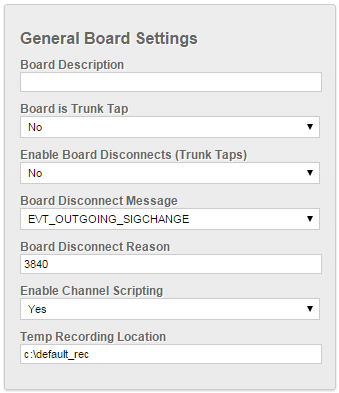
- Board Description
- Allows you to provide an identifying description of the voice board. NICE Uptivity standard practice is to type the serial number of the associated physical Ai-Logix card.
- Board is Trunk Tap
- Defines whether the associated Ai-Logix card will be used as a trunk-tap or station-tap card. The field accepts the values Yes or No from a drop-down list, with No as the default.
- Enable Board Disconnects (Trunk Taps)
- The field accepts the values Yes or No from a drop-down list, with the No as the default.
- Board Disconnect Message
- The field accepts the values EVT_OUTGOING_SIGCHANGE or EVT_INCOMING_SIGCHANGE from a drop-down list, with EVT_OUTGOING_SIGCHANGE as the default.
- Board Disconnect Reason
- The default value is 3840.
- Enable Channel Scripting
- Specifies whether the voice board should use Uptivity integration channel scripts. The field accepts the values Yes or No from a drop-down list, with Yes as the default.
- Temp Recording Location
- If recordings are not stored locally, this setting allows you to provide a path to a local directory where files may be stored until recording is complete. Files are then copied to the remote location specified in the UNC Paths. The default value is C:\default_rec.
Voice Boards for Ai-Logix DT Cards
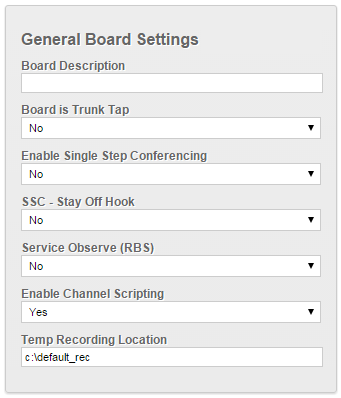
- Board Description
- Allows you to provide an identifying description of the voice board. NICE Uptivity standard practice is to type the serial number of the associated physical Ai-Logix card.
- Board is Trunk Tap
- Defines whether the associated Ai-Logix card will be used as a trunk-tap or station-tap card. The field accepts the values Yes or No from a drop-down list, with No as the default.
- Enable Single Step Conferencing
- The field accepts the values Yes or No from a drop-down list, with the No as the default.
- SSC - Stay Off Hook
- The field accepts the values Yes or No from a drop-down list, with the No as the default.
- Service Observe (RBS)
- Specifies whether robbed-bit signaling (RBS) is used for service observe. The service observe code is typically dialed in-band. The field accepts the values Yes or No from a drop-down list, with the No as the default.
- Enable Channel Scripting
- Specifies whether the voice board should use Uptivity integration channel scripts. The field accepts the values Yes or No from a drop-down list, with Yes as the default.
- Temp Recording Location
- If recordings are not stored locally, this setting allows you to provide a path to a local directory where files may be stored until recording is complete. Files are then copied to the remote location specified in the UNC Paths. The default value is C:\default_rec.
Voice Boards for Ai-Logix LDA or NGX Cards
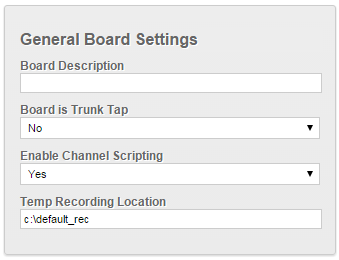
- Board Description
- Allows you to provide an identifying description of the voice board. NICE Uptivity standard practice is to type the serial number of the associated physical Ai-Logix card.
- Board is Trunk Tap
- Defines whether the associated Ai-Logix card will be used as a trunk-tap or station-tap card. The field accepts the values Yes or No from a drop-down list, with No as the default.
- Enable Channel Scripting
- Specifies whether the voice board should use Uptivity integration channel scripts. The field accepts the values Yes or No from a drop-down list, with Yes as the default.
- Temp Recording Location
- If recordings are not stored locally, this setting allows you to provide a path to a local directory where files may be stored until recording is complete. Files are then copied to the remote location specified in the UNC Paths. The default value is C:\default_rec.
Voice Boards for Avaya DMCC
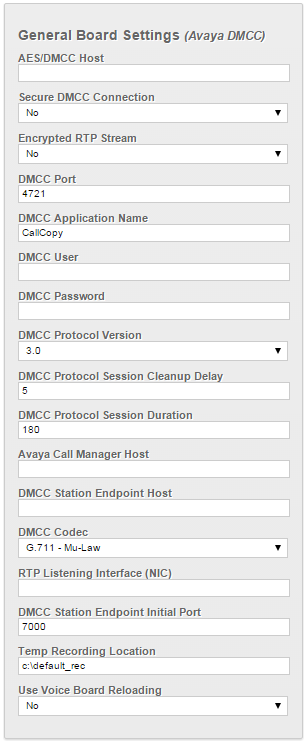
- AES/DMCC Host
- Displays the host name or IP address of the Avaya AES server.
- Secure DMCC Connection
- Allows you to specify whether the Avaya DMCC application should use SSL when connecting to the AES server for DMCC communication and events. Secure communication requires that an avaya.crt file be added to the recording server's certificate store. This setting works in conjunction with Encrypted RTP Stream, DMCC Port, and DMCC Protocol Version. The field accepts the values Yes or No from a drop-down list, with No as the default.
- Encrypted RTP Stream
- Allows you to specify that the DMCC stations should use AES encryption. This setting works in conjunction with Secure DMCC Connection, DMCC Port, and DMCC Protocol Version. The field accepts the values Yes or No from a drop-down list, with No as the default.
- DMCC Port
- Displays the port the DMCC service uses on the AES server. The default value is 4721.
- DMCC Application Name
- Displays the application name passed by Uptivity to the AES server during session start-up.
- DMCC User
- Displays the username for the account Uptivity uses to authenticate to the AES server during DMCC session start-up.
- DMCC Password
- Displays the password for the DMCC User account.
- DMCC Protocol Version
- Displays the DMCC protocol version Uptivity identifies itself as using during session startup. The field accepts the values of 3.0, 3.1, or 4.0 from a drop-down list, with 3.0 as the default.
- DMCC Protocol Session Cleanup Delay
- Specifies the number of seconds between Uptivity's attempts to connect to the AES server. The default value is 5.
- DMCC Protocol Session Duration
- Uptivity sends keep-alive events to the AES server to prevent the session from timing out. This setting determines the amount of time (in seconds) to allow between missed keep-alive events before the session is closed. Uptivity divides this interval by three and sends keep-alive events with that frequency, thus allowing two keep-alive events to be missed without timing out the session. The default value is 180.
- Avaya Call Manager Host
- Displays the host name or IP address of the gatekeeper that registers the DMCC stations.
- DMCC Station Endpoint Host
- Displays the host name or IP address of the server that receives RTP/RTCP traffic from the Avaya Call Manager. This is typically the Uptivity recording server.
- DMCC Codec
- Displays the codec used for audio. The voice board(s), Avaya Call Manager, and telephones being recorded should all use the same codec. Some combinations of codecs can prevent audio from recording. The field accepts the values G.711 - Mu-Law, G.711 - A-Law, G.729, or G.729 Annex A, with G.711 - Mu-Law as the default.
- RTP Listening Interface (NIC)
- Displays the network interface card (NIC) on the Uptivity recording server that is dedicated to receiving RTP traffic.
- DMCC Station Endpoint Initial Port
- Displays the starting RTP port for the DMCC stations to be recorded. The default value is 7000.
- Temp Recording Location
- If recordings are not stored locally, this setting allows you to provide a path to a local directory where files may be stored until recording is complete. Files are then copied to the remote location specified in the UNC Paths. The default value is C:\default_rec.
- Use Voice Board Reloading
- Specifies whether to allow dynamic reallocation of voice board channels so that can add or remove extensions from Uptivity without restarting the CTI Core. This is a licensed feature that is supported only in Avaya DMCC-MR integrations. The field accepts the values Yes or No from a drop-down list, with No as the default.
Voice Boards for Cisco active recording
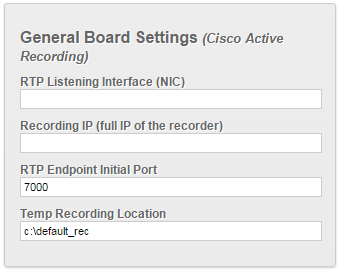
- RTP Listening Interface (NIC)
- Displays the network interface card (NIC) on the Uptivity recording server that is dedicated to receiving RTP traffic.
- Recording IP
- Displays the IP address assigned to the RTP Listening Interface NIC. This should be a dedicated NIC reserved exclusively for this purpose.
- RTP Endpoint Initial Port
- Displays the starting port for the stations to be recorded. The default value is 7000.
- Temp Recording Location
- If recordings are not stored locally, this setting allows you to provide a path to a local directory where files may be stored until recording is complete. Files are then copied to the remote location specified in the UNC Paths. The default value is C:\default_rec.
Voice Boards for mitel src recording

- RTP Listening Interface (NIC)
- Displays the network interface card (NIC) on the Uptivity recording server that is dedicated to receiving RTP traffic.
- Recording IP
- Displays the IP address assigned to the RTP Listening Interface NIC. This should be a dedicated NIC reserved exclusively for this purpose.
- RTP Endpoint Initial Port
- Displays the starting port for the stations to be recorded. The default value is 7000
- Temp Recording Location
- If recordings are not stored locally, this setting allows you to provide a path to a local directory where files may be stored until recording is complete. Files are then copied to the remote location specified in the UNC Paths. The default value is C:\default_rec.
Voice Boards for Avaya (Nortel) MLS recording

- Recording IP
- Displays the IP address assigned to the RTP Listening Interface NIC. This should be a dedicated NIC reserved exclusively for this purpose.
- RTP Listening Interface (NIC)
- Displays the network interface card (NIC) on the Uptivity recording server that is dedicated to receiving RTP traffic.
- RTP Endpoint Initial Port
- Displays the starting port for the stations to be recorded. The default value is 7000
- Generate Warning Tone
- Specifies whether a warning tone is used to let the call participants know the call is being recorded. The field accepts the values Yes or No from a drop-down list, with No as the default.
- Temp Recording Location
- If recordings are not stored locally, this setting allows you to provide a path to a local directory where files may be stored until recording is complete. Files are then copied to the remote location specified in the UNC Paths. The default value is C:\default_rec.
Voice Boards for RTP Logger
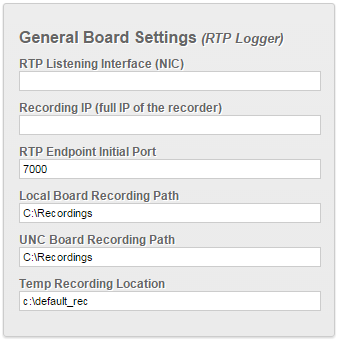
- RTP Listening Interface (NIC)
- Displays the network interface card (NIC) on the Uptivity recording server that is dedicated to receiving RTP traffic.
- Recording IP
- Displays the IP address assigned to the RTP Listening Interface NIC. This should be a dedicated NIC reserved exclusively for this purpose.
- RTP Endpoint Initial Port
- Displays the starting port for the stations to be recorded. The default value is 7000.
- Local Board Recording Path
- UNC Board Recording Path
- Temp Recording Location
- If recordings are not stored locally, this setting allows you to provide a path to a local directory where files may be stored until recording is complete. Files are then copied to the remote location specified in the UNC Paths. The default value is C:\default_rec.
Voice Boards for ShoreTel media Redirection

- Route Point Extension
- Displays the Route Point created in ShoreTel Director.
- Local Recording Directory
- Displays the path to the local directory where ShoreTel delivers the recorded WAV files for use by Uptivity.
- Logging Server Port
- Displays the TCP port on which the ShoreTel module listens for communications from the Logger service. The default value is 2003.
Voice Boards for VoIP sniffer
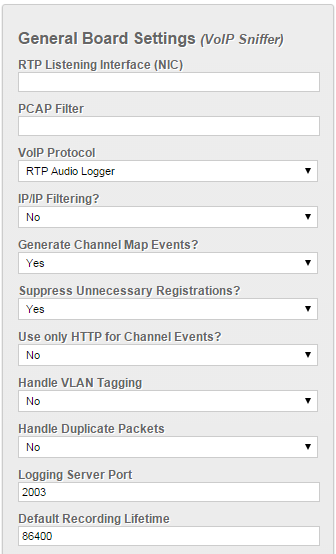
- RTP Listening Interface (NIC)
- Displays the network interface card (NIC) on the Uptivity recording server that is dedicated to receiving RTP traffic.
- PCAP Filter
- May be used to specify a standard WinPcap capture filter if unnecessary traffic cannot be filtered at the network level.
- VoIP Protocol
- Specifies the signaling protocol used by the phones to be recorded so that Uptivity can process call control events.
- IP/IP Filtering?
- Allows you to filter based on IP. The field accepts the values Yes or No from a drop-down list, with No as the default.
- Generate Channel Map Events?
- This setting is no longer used.
- Suppress Unnecessary Registrations?
- Specifies whether the voice board should only generate device registration events if the registration data changes from the current data. The field accepts the values Yes or No from a drop-down list, with Yes as the default.
- Use Only HTTP for Channel Events
- This setting is no longer used.
- Handle VLAN Tagging
- Specifies whether VoIP traffic is tagged by a VLAN so that Uptivity can remove the tag before processing to prevent errors. The field accepts the values Yes or No from a drop-down list, with No as the default.
- Handle Duplicate Packets
- Specifies whether Uptivity should filter out duplicate VoIP traffic. The field accepts the values Yes or No from a drop-down list, with No as the default.
- Logging Server Port
- Displays the TCP port on which the module listens for connections from the Logger service. The default value is 2003.
- Default Recording Lifetime
- Specifies a global timeout setting to end recordings if no stop event is received. The field accepts positive numeric values, with a default value of 86400 seconds (24 hours). This setting is only used if Max Record Length is not set in the recording schedule.
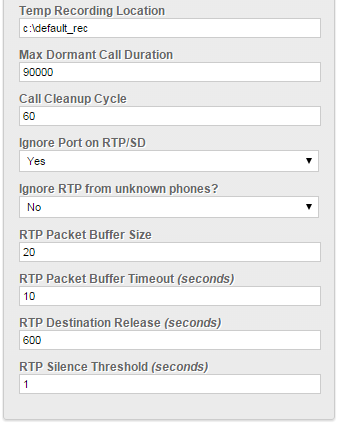
- Temp Recording Location
- If recordings are not stored locally, this setting allows you to provide a path to a local directory where files may be stored until recording is complete. Files are then copied to the remote location specified in the UNC Paths. The default value is C:\default_rec.
- Max Dormant Call Duration
- Specifies a global timeout setting to end recordings if no stop-recording event is triggered. The field accepts positive numeric values, with a default value of 90000 seconds (25 hours). This setting is used only if Max Silence Length is not set in the recording schedule.
- Call Cleanup Cycle
- This setting is no longer used.
- Ignore Port on RTP/SD
- Specifies whether Uptivity considers port information in an IP address. The field accepts the values Yes or No, with Yes as the default.
- Ignore RTP from Unknown Phones
- Can be used to limit the audio acquired by Uptivity. The field accepts the values Yes or No, with No as the default.
- RTP Packet Buffer Size
- Used to compensate for signaling delays in systems that rely on those events for call control. The field accepts a positive numeric value, with a default value of 20. This number represents buffer size, not time.
- RTP Packet Buffer Timeout
- Specifies how many seconds Uptivity should wait before discarding the last received RTP packet if another is not received. The field accepts a positive numeric value, with a default value of 10.
- RTP Destination Release
- Specifies the length of time in seconds that the recorder retains tracking data on an IP address after a call ends. If another call is received before this threshold is reached, Uptivity does not have to rebuild tracking information about that IP address. The fields accepts a positive numeric value, with a default value of 600.
- RTP Silence Threshold
- Specifies the number of seconds that an RTP stream must remain silent before Uptivity sends an RTP_STATUS 0 event to indicate the stream has stopped. The field accepts a positive numeric value, with a default value of 1.
- PBX Addresses
- Displays the IP address of any non-endpoint device that would send RTP or signaling traffic. Use the Add or Remove buttons to edit the addresses displayed.
Sound Settings
Sound Settings apply only to voice boards for Ai-Logix cards.

- Play a Continuous Sound
- Specifies that a beep tone should be inserted at regular intervals into calls recorded by the associated Ai-Logix card. This tone is inaudible to callers and agents. The field accepts the values of Yes or No from a drop-down list, with No as the default.
- Continuous Beep Amplitude/Volume
- Specifies the volume of the generated tone in decibels (dB). The field accepts positive or negative numeric values in a range from 3 to -60, with a default of -14.1.
- Continuous Beep - Tone Frequency
- Specifies the pitch of the generated tone in hertz (Hz). The field accepts numeric values, with a default of 1400.
- Continuous Beep - Interval
- Specifies the number of seconds between beep tones. The field accepts numeric values, with a default of 15.
- Continuous Beep - Tone Duration
- Specifies in milliseconds how long the beep tone lasts. The field accepts numeric values, with a default of 750.
Automatic Gain Control (AGC) Settings
Automatic Gain Control Settings apply only to voice boards for Ai-Logix cards.
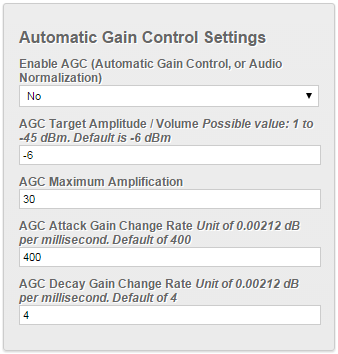
- Enable AGC
- Specifies whether the associated Ai-Logix card should attempt to even out (normalize) audio between the called and calling parties to keep the volume consistent. The field accepts the values of Yes or No from a drop-down list, with No as the default.
- AGC Target Amplitude/Volume
- Specifies the volume to which the card will attempt to normalize audio in decibel-milliwatts (dBm). The field accepts positive or negative numeric values in a range from 1 to -45, with a default of -6.
- AGC Maximum Amplification
- Specifies the maximum number of decibels (dBs) a channel will be adjusted during normalization. The field accepts numeric values, with a default of 30.
- AGC Attack Gain Change Rate
- Determines how quickly AGC responds to a changing input level. Longer attack times result in slower change; shorter attack times result in faster change. The field accepts numeric values, which express units of 0.00212 dB per millisecond. The default is 400.
- AGC Decay Gain Change Rate
- Determines how quickly AGC responds to a changing input level. Longer decay times result in slower change; shorter decay times result in faster change. The field accepts numeric values, which express units of 0.00212 dB per millisecond. The default is 4.
Silence Detection Settings
Silence Detection Settings apply only to voice boards for Ai-Logix cards.
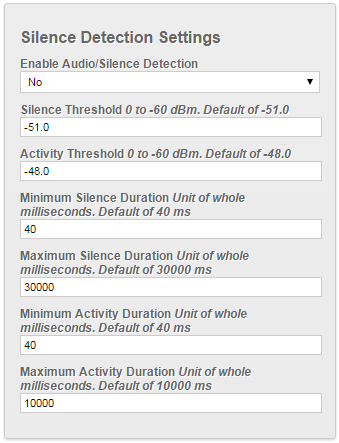
- Enable Audio/Silence Detection
- Used to enable audio/silence detection on the associated Ai-Logix card for integration channel scripts that require it. The field accepts the values of Yes or No from a drop-down list, with No as the default.
- Silence Threshold
- Specifies the dBm volume that audio on the channel must drop below to trigger a silence event. The field accepts numeric values in a range from 0 to -60, with a default of -51.
- Activity Threshold
- Specifies the dBm volume that audio on the channel must rise above to trigger an activity event. The field accepts numeric values from 0 to -60, with a default of -48.
- Minimum Silence Duration
- Specifies the minimum time in milliseconds that the volume level must stay below the Silence Threshold for an event to be triggered. The default is 40.
- Maximum Silence Duration
- Specifies the maximum time in milliseconds that audio can be below the Silence Threshold before another event is triggered. The field accepts numeric values up to 65,535; setting a value higher than this causes the system to reset to 1000. The default is 30,000 (30 seconds).
- Minimum Activity Duration
- Specifies the minimum time in milliseconds that the volume level must stay above the Activity Threshold for an event to be triggered. The field accepts numeric values, with a default of 40.
- Maximum Activity Duration
- Specifies the maximum time in milliseconds that audio can stay above the Activity Threshold before another event is triggered. The field accepts numeric values, with a default of 10000 (10 seconds).
UNC Paths

UNC Paths apply to all voice boards. This section allows you to provide UNC path values that tell the voice board where to copy recordings when complete. However, best practice is to establish these storage locations in the recording schedule. For more information, see .
Channels
Channels apply to all voice boards. This section allows you to configure the individual channels that will be recorded using this voice board. The fields for each channel vary depending on the integration. The image shown here is for a Nortel MLS voice board.
- Number of Channels to Add
- Allows you to specify the number of channels you are adding to the voice board. This field is not available if the voice board is associated with an Ai-Logix card, where the fixed number of channels for the card is shown at all times.
- Channel ID
- Applies to all voice boards. This field displays the internal identifier assigned to the channel by Uptivity. As you are adding channels, the field displays a temporary ID (for example, -1, -2, and so forth). When you save the new channels, the ID is assigned and displayed.
- Assign
- Applies to all voice boards. This field is used in deployments where physical devices and channels have a one-to-one correspondence, or to allocate specific channels to specific types of recording. The field accepts values from a drop-down list (see Channel Assignment Settings), with Anything as the default.
- Assign Val
- Applies to all voice boards. This field displays the identifier for the device assigned to the channel (typically the phone extension). This field applies to all voice boards.
- Station
- Applies only to Avaya DMCC voice boards. This field displays the DMCC station associated with the channel.
- Password
- Applies only to Avaya DMCC voice boards. This field displays the password for the Station.
- Name
- Applies to all voice boards. This fields displays the name established when the channel was added.
- Desc
- Applies only to voice boards associated with Ai-Logix cards. This field displays a description of the channel.
- Polarity
- Applies only to voice boards associated with Ai-Logix LDA or NGX cards. This field specifies the polarity of the channel. It accepts the following values from a drop-down list: Default, Normal, or Reverse. The default value is Default.
- Voltage Low
- Applies only to voice boards associated with Ai-Logix LDA cards. This field specifies a numeric value used to determine when a physical phone has been taken off-hook. A value is required only when on/off hook signaling is used to determine recording start and stop.
- Voltage High
- Applies only to voice boards associated with Ai-Logix LDA cards. This field specifies a numeric value used to determine when a physical phone has been placed back on-hook. A value is required only when on/off hook signaling is used to determine recording start and stop.
- Deglitch
- Applies only to voice boards associated with Ai-Logix LDA cards. This field determines the length of time in milliseconds that voltage must stay past the Voltage Low or Voltage High threshold before an event is issued. The field accepts numeric values, with 50 as the default.
- Trunk Tap
- Applies only to voice boards associated with Ai-Logix cards. This field specifies whether the trunk-tapping capability of the physical card should be used. The default for this checkbox is cleared.
channel assignment settings
- Not in Use
- Identifies a channel that is licensed but not currently used.
- Anything
- Allows the channel to be used for all recording and playback events, as determined by schedule priorities.
- Playback Anything
- Limits the channel to playback of recordings via telephone.
- Record Anything
- Allows the channel to be used for any scheduled or API-triggered recording.
- Instant Record
- Dedicates channel to instant recording requests from the Uptivity API.
- Dedicated Record ACD Group
- Limits the channel to recording only the specified ACD/PBX group (not QA Group), independently of any schedules.
- Dedicated Record Device ID
- Limits the channel to recording a specific hardware resource (such as a voice port or DN) on the ACD/PBX.
- Dedicated Record Agent ID
- Limits the channel to recording a specific agent-based identifier (such as agent login or extension).
- Dedicated Record Dialed Number
- Limits the channel to recording a specific inbound number, such as an 800-number carrying traffic to your facility.
- Dedicated Record Caller ID
- Limits the channel to recording a specific ANI (Caller ID). The associated Assign Val can be a full or partial ANI match (for example, an area code only).
- Dedicated Record User (1,2,3,4,5)
- Limits the channel to recording based on a specific value placed in one of the first five user fields by the Uptivity API (for example, an account or case number.
- Playback and Instant Record
- Limits the channel to playback and instant recording requests from the API.
- Playback and Record
- Limits the channel to scheduled recordings and playback via telephone.
- Record and Instant Record
- Limits the channel to recording only, but of any recording type.
- Unlicensed
- Identifies a channel which is present (for example, on a physical audio capture card) but is not licensed.
Related Tasks
- Create Voice Boards
- Edit Voice Boards
- Add Channels to a Voice Board
- Edit Voice Board Channels
